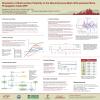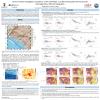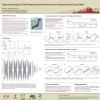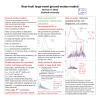Poster #207, Ground Motions
3D wave propagation simulations of the 2019 M7.1 Ridgecrest, CA, Earthquake
Poster Image:

Poster Presentation
2020 SCEC Annual Meeting, Poster #207, SCEC Contribution #10511 VIEW PDF
curvilinear grids (O'Reilly et al., 2019). We used the velocity and density information from the SCEC UCVM model CVM-S4.26.M01 that has built-in geotechnical layers (Small et al., 2017), with a velocity-dependent anelastic attenuation model (Qs=0.05Vs, Qp=2Qs). The 3-segment finite-fault source was generated by a kinematic rupture generator (Graves & Pitarka, 2016). We used different metrics to examine the spatial variation of ground motion, including peak ground velocity (PGV), cumulative kinetic energy, and duration of shaking. The values and spatial pattern of PGV predicted by the simulations both with and without surface topography are generally in good agreement with data, where the topographic scattering reduces the PGV by 6% on average. This indicates that the surface topography did not largely alter the peak ground velocity significantly for frequencies below 1.5 Hz. Our simulations also show that surface topography can prolong the duration of shaking due to additional scattered waves generated at the free surface and bring the predicted durations closer to the observed values. While the simulations generally reproduce most features in the spatial pattern of the cumulative kinetic energy, both models with and without topography tend to underpredict the values. We plan to further investigate the effects of small-scale heterogeneities in the medium and the sensitivity to the rupture model within the current frequency range. As we move toward higher frequencies, more investigations will be conducted for the combined effects of small-scale heterogeneities and the power-law exponent of the frequency-dependent anelastic attenuation, Q(f).
SHOW MORE
SHOW MORE



















































